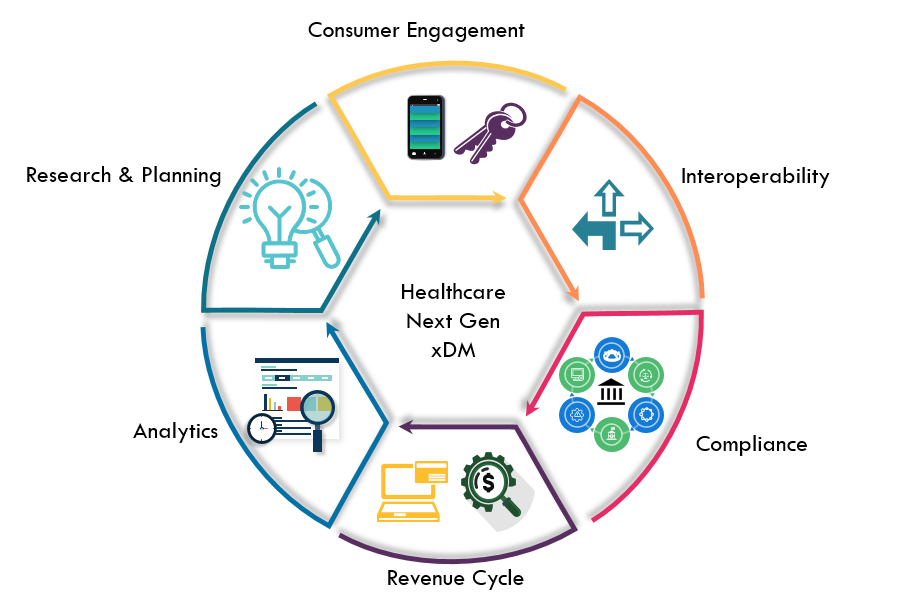As a Semarchy Partner, IMT is applying 30 years of experience to tailor the xDM platform for the unique needs of healthcare clients. This first blog of a three-part series focuses on how healthcare leaders plan to use next-generation multidomain master data management software and analytics tools to transform their organizations.
Healthcare has a very unique set of information governance, management, data exchange protocols, and standards. Master Data Management became an urgent need in Healthcare 20 years ago as an “EMPI” with the focus on creating a high degree of data integrity to support the sharing of clinical patient information across disparate source systems like EHRs, Revenue Cycle, Registration, and Clinical Fulfillment Systems. Healthcare leaders now recognize that they must transform their “EMPI” to a multi-domain Data Hub to respond to rapid change and deliver tangible clinical and business benefits to their stakeholders.
Over the past two years, we have spent a lot of time talking to our clients to understand where they plan to drive more value from quality, trusted data. We have identified six key “initiatives” that rely on expanding the EMPI to a multi-domain Data Hub:

1. Consumer Engagement
Many healthcare organizations now use their EMPI for loyalty-building engagement initiatives to enhance and improve the client experience. In private healthcare, consumers have more choices than ever for their healthcare, especially in densely populated areas. Public healthcare struggles with increasing demands for digital services transformation. All healthcare organizations need to prove that they truly know their clients to meet expectations and retain them.
Self-service portals, online appointment scheduling or bill payment, smartphone alerts and reminders, virtual consultations via video chat, and patient self-monitoring are all part of enhanced client engagement. Achieving this requires a single trusted view of all client data that supports consumer preferences and enforces individual privacy and consent directives. And that’s where the Data Hub comes in.
When healthcare organizations do this well — when the data can truly be trusted — they see significant boosts to client and caregiver confidence, overall satisfaction, and more client participation in their care.
2. Interoperability
The first EMPIs focused on a narrow set of identity data to uniquely identify a client (typically a patient) at the point of encounter. Today, the demand to include new data domains (e.g., Providers, Organizations, and Locations) and integrate data from outside sources (other health systems, public health data, or reference data) into the EMPI is growing exponentially. Enterprise EHR vendors promised a “single view of patient,” but challenges remain particularly when it comes to external sources of data and interoperability initiatives. This drives the need for semantic interoperability. One of our clients summed up a sentiment echoed by many: “Our EMPI provides trusted data that is essential to drive interoperability.”
A data hub can curate, tag, cross reference, and integrate data across a sprawling enterprise. This has become more urgent as the sheer volume of EHRs, data warehouses, and data lakes continue to grow. And with more mergers and acquisitions on the horizon, rich interoperability helps clients to onboard new providers and integrate their patient’s data into a single combined clinical record, while reducing costs and accelerating timelines.
Read how Next Generation MDM can overcome the interoperability shortfalls of Single Enterprise EHRs.
3. Compliance
Healthcare leaders now realize the critical importance of Master Data Management to navigate the ever-changing compliance landscape. Many have created automated processes that manage opt-in/opt-out preferences, tailored to state or province-specific requirements. Some use these same processes to balance marketing’s data needs with HIPAA and GDPR compliance and governance requirements. One client said it best: “Our EMPI is the watchdog for our entire enterprise — it allows us to democratize our data.”
As organizations like the ONC drive organizations to broader data sharing through the CURES Act, a trusted Data Hub is critical to define and manage compliance with complex governance requirements such as consent, freedom of information requests, data retention policies, and audits.
4. Revenue Cycle
Over the past decade, we have helped many clients expand their EMPI to support intensifying revenue cycle needs. While some use cases are straightforward — using the EMPI to better identify patients to streamline intake and support billing — others are more advanced.
Some revenue cycle teams use the EMPI to detect fraud, while others identify uninsured patients to enroll in their organization’s health plan. Others have improved their billing processes, using the EMPI’s trusted view to deliver a single consolidated bill to patients, or aggregate parent-child bills into a single statement using data relationships. While cutting costs and complexity for the billing departments, these initiatives also help improve consumer engagement — and more timely payments.
Some revenue cycle initiatives use the EMPI to coordinate with accountable care organizations. One client noted, “Our biggest stakeholders now are the ACOs and value-based plans; they require a single, trusted view of patient data.” Read more about how clients use patient and provider data to support value-based care programs.
5. Analytics
Everyone is “doing” analytics, and we see a wide variety of approaches producing great variability in benefits realization. Successful organizations have well-established comparative analytics programs, while others are making progress with leading edge cloud technologies for predictive analytics. The “enterprise ID” often serves as the linking mechanism for such analytics – something a Data Hub must provide.
Many healthcare organizations have plans to incorporate artificial intelligence into their strategic initiatives. An Intel study found that in pre-pandemic 2020, 45% of healthcare decision-makers currently use, or plan to use AI technologies. By late 2020, that number had skyrocketed to 84%. Another recent survey found that 95% of healthcare executives plan to hire staff with experience developing AI. A Data Hub provides a foundation for any successful data analytics program by providing high-quality mastered data, rich relationships, and full semantic interoperability.
6. Research and Planning
Research teams use their organizations’ EMPIs today to aggregate and anonymize patient data and identify target populations for clinical trials or other population health cohorts. This approach is now being adopted by other areas of the healthcare organization as well. For example, last spring one organization faced with a PPE shortage turned to their EMPI to assess practice patterns among their providers. Others have explored contact tracing use cases to help track COVID-19 exposures among the workforce. And some use their EMPI data to assess potential targets for mergers and acquisitions, aiming to understand the overlap between existing patient or provider pools.
One of our clients once said, “Nothing is out of scope of the EMPI.” We agree, and we are excited to help our clients make progress against their 2021 initiatives with a Data Hub built on the Semarchy xDM platform.
Join us for the second blog in this series that will focus on what healthcare organizations should expect from a next-generation Master Data Management platform to realize this vision and drive rapid time to value.
7. Discover IMT Health:iDM
Semarchy and IMT have partnered to develop IMT Health:IDM, the next generation of intelligent healthcare data management. Health:iDM improves the EMPI experience and re-thinks how organizations now manage health data all while being cost-effective.




